
Teddy Sears as Jay Garrick in The Flash Ep. 2.01 “Flash of Two Worlds” © 2015
CW Network. Photo: Cate Cameron. Character TM/® DC Comics.
I didn’t see Tuesday’s Flash episode until after midnight — so it ended up a birthday present. And it was a gift to all the fans who’ve loved DC’s multiverse for decades. I’m honestly not able to put my reaction into words, because it basically involved giving
the astral projection of my 6-year-old self a high-five.
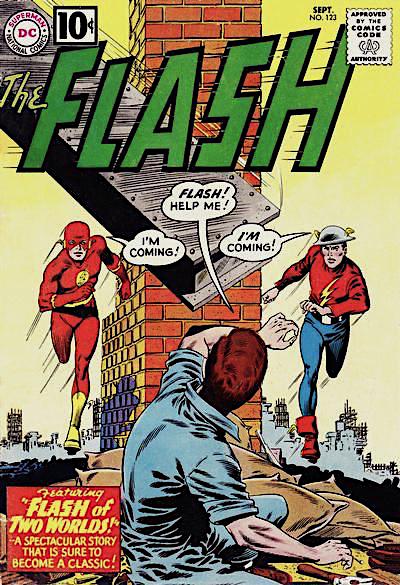
Cover to The Flash #123 © 1961 and elements TM/® DC Comics.
Pencils: Carmine Infantino. Inks: Murphy Anderson. Letters:
Ira Schnapp. Colors: Unknown. Editing: Julius Schwartz.
To recap, brief as possible given me being me, for those of you who only know the
CW Flash:
Superman’s 1938 debut in Action Comics #1 sparked a massive boom of costumed, powered and/or gimmicked-up crimefighters on American newsstands spanning World War II, but the genre’s popularity waned considerably in the years after. It was just the Big Three at DC — plus their supporting casts and select back-up features in series they headlined — who saw publication from the so-called Golden Age straight through the ’50s. Then experimentation birthed revolution as once-well-known, second-tier characters were (to use 21st-century terminology) reimagined, starting with a new
Flash in the form of police scientist Barry Allen.
The return of the original versions of these reimaginings began in “Flash of Two Worlds” in 1961’s Flash #123, when Barry traveled to a parallel universe and met his predecessor Jay Garrick. Barry’s world got dubbed Earth-One, while Jay’s was labeled Earth-Two. More of the multiverse was explored over time, often during the annual meetings of Earth-One’s Justice League and Earth-Two’s Justice Society. Barry Allen’s 1956 introduction in the tryout mag Showcase had led to his own series at the tail end of 1958; it launched with #105 thanks to DC picking up from where Flash Comics, the anthology fronted by Jay Garrick, had folded 10 years earlier, which is how it got to #123 so fast. [Since it’s such a fun Flash fact I should also mention that the first Barry Allen story opens on him reading about Jay Garrick in Flash Comics, a grace note that eventually became a plot element as the multiverse developed.]
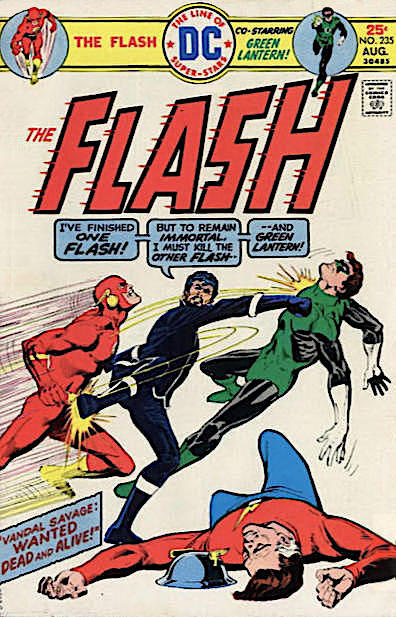
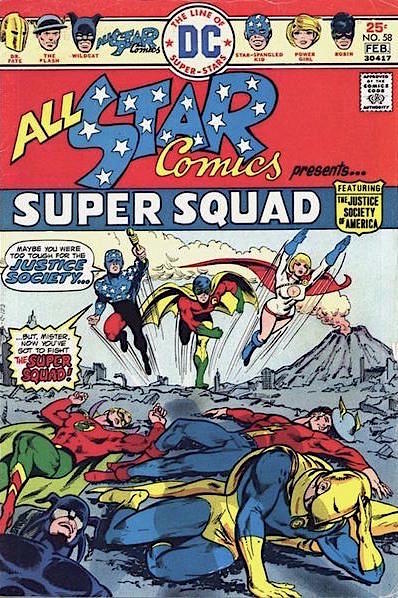
Covers to The Flash #235 and All-Star Comics #58 © 1975 and elements TM/® DC Comics.
Pencils, Inks: Dick Giordano; Mike Grell. Letters: Gaspar Saladino (both). Colors:
Tatjana Wood (both). Editing: Julius Schwartz; Gerry Conway.
Flash #235 was among my earliest comics and likely my very first exposure to DC’s alternate Earths. Earth-One’s Green Lantern and Earth-Two’s Flash co-starred in the issue, which had the heroes battling Vandal Savage — the main antagonist in CW’s upcoming time-traversing Flash/Arrow spinoff Legends of Tomorrow. Later the same year I picked up the relaunch of the Justice Society’s own adventures on Earth-Two in All-Star Comics #58. (I’ve just now noticed, having put them side by side, that both those comics sport covers in which Jay Garrick is lying unconscious on the ground.)
Due to my parents and whatever nature combined with the nurture, I’d been an early reader and by my fifth birthday in 1975 I was already determined to amass as many comics as I could that had Golden Age reprints — including such faithful replicas as the oversized Famous 1st Edition of Flash Comics #1 — and recent issues starring Golden Age characters. Flash #123 became my holy grail once I really began collecting, given that something like the first appearance of Superman or Batman in anything other than facsimile form would forever be beyond my grasp. Close behind it were Green Lantern #40, revealing the origin of the multiverse, and Justice League of America #21 & #22, the League’s inaugural team-up with the Justice Society.

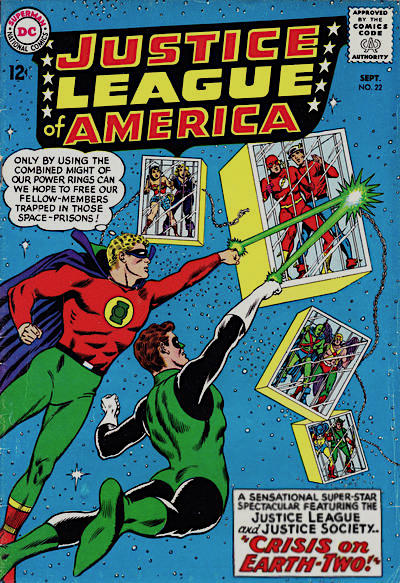
Covers to Justice League of America #21 and Justice League of America #22 © 1963 and
elements TM/® DC Comics. Pencils: Mike Sekowsky; Murphy Anderson. Inks: Murphy Anderson
(both). Letters: Ira Schnapp (both). Colors: Unknown. Editing: Julius Schwartz.
This week’s Flash episode borrowed the “Flash of Two Worlds” title from its comics inspiration, and its highlight — when my eternal inner child let out the transcendental, metaphysical squee referenced earlier — came the fleeting moment homage was paid to that cover of Flash #123.
Merely seeing Jay Garrick embodied onscreen in a smart real-world, present-day spin on his familiar outfit was a thrill, of course, as I didn’t expect the indescribably cool sight of his trademark winged helmet skidding through the temporal vortex in last season’s finale to be more than a wink to fans like me before plans for this season were unveiled. And while I can’t help wishing Jay was a slightly older, white-templed fellow, my only major quibble with the episode was — no matter how much it might’ve made sense in story terms — Barry’s initial, ongoing mistrust of him. Flash isn’t perfect television and it certainly takes liberties with the source material, even accounting for the fact that said source material includes over 75 years of history often rewritten, but on the whole it’s greater than my 6-year-old self would ever have dared to dream.
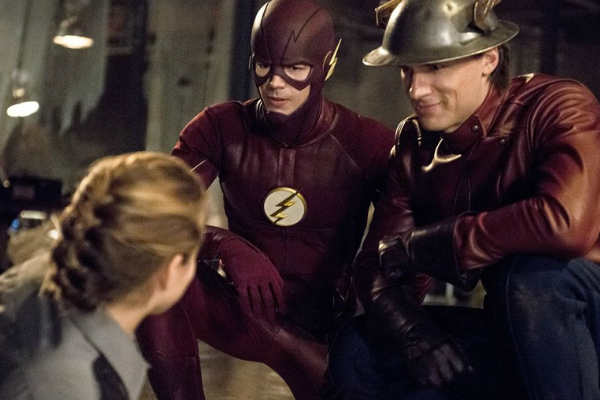
Grant Gustin as Barry Allen and Teddy Sears as Jay Garrick in The Flash Ep. 2.01 “Flash
of Two Worlds” © 2015 CW Network. Photo: Cate Cameron. Characters TM/® DC Comics.
Related: Number Ones • Who’s Zoomin’ Who • Schwartz
Illustrated • When Barry Met Ollie • Hope of Good Capes

Test
ReplyDelete